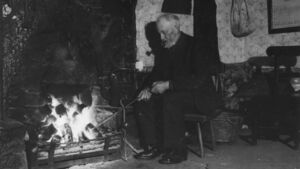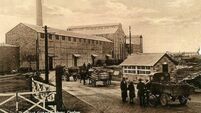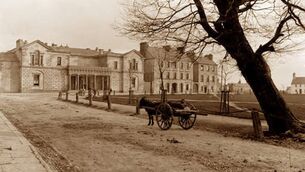Old homes that once bustled with life

A man stokes his fire in an old Irish cottage in the 1940s. Picture: Ron Bell/Fox Photos/Getty Images
When I was a child in the 1970s we used to visit a family relative and while away a few hours of the night in the rambling house days. They were the best of times and the people still had time for each other despite the advent of the TV and the radio boom. The older people loved to sit beside the hearth and there would be a roaring fire to keep them warm on the winter rambling night.
In my relative’s house there was an outshot of the 19th-century cottage with its three rooms. This was the place for the cailleach bed where the older people in the house would rest for the night and they would be warm and cosy by the fireside whilst the rest of the family slept in the room above and the room below. The living area would be in the centre and this also served as a kitchen with the cooking done on the open fire with turf. There was a crane and crook on the fire place which would be much wider than what we are accustomed to today, indeed there are no hearths and chimneys in new-build houses these times.
As the night wore on, little eyes would grow weary and bleary and then they would take me and put me gently into the bed shot or cailleach bed and I can still see the Sacred Heart lamp on the wall and the face of the Saviour radiating from it to soothe me to sleep. I could still hear the voices of the ramblers as they chatted for the last hour of the visit and then I would find myself being lifted softly from the soft feather bed and being placed in the car to bring me home.
Over the years, time went by and the house that had been there since the 1830s began to crumble. I later learned that Anthony Foy lived there in 1851 with his wife Ellen (nee Melvin) and his young family in the years after the Great Hunger that decimated life in the country areas from 1845 to 1850. The Foys survived the Famine because they were herds for the Atkinson landed family.
Our relative could not afford the upkeep and maintenance of the house and he let it be. It slowly became a ruin or derelict structure and the last house in that small town land was no longer inhabited. The house was replaced by a pre-fabricated structure that was not as sturdy as the former house. Our relative contracted leukaemia and died in December 1998 at an all too early age.
The pre-fabricated building soon fell apart and is there as a shell and people who pass by would find it hard to believe that in 1856 there were three families living there in three houses. Such is life. As the old saying goes, the fence remains after the man who built it is no longer, agus tá sé ar shli na Firinne and at peace with the Lord and Saviour who shone so brilliantly in the Sacred Heart lamp in the comfy bed where I slumbered as a child over five decades ago.
The years have brought their changes and I am a wiser, older person and see life for what it is: a transient thing where time or tide waits for no man as my grandmother used to say.





